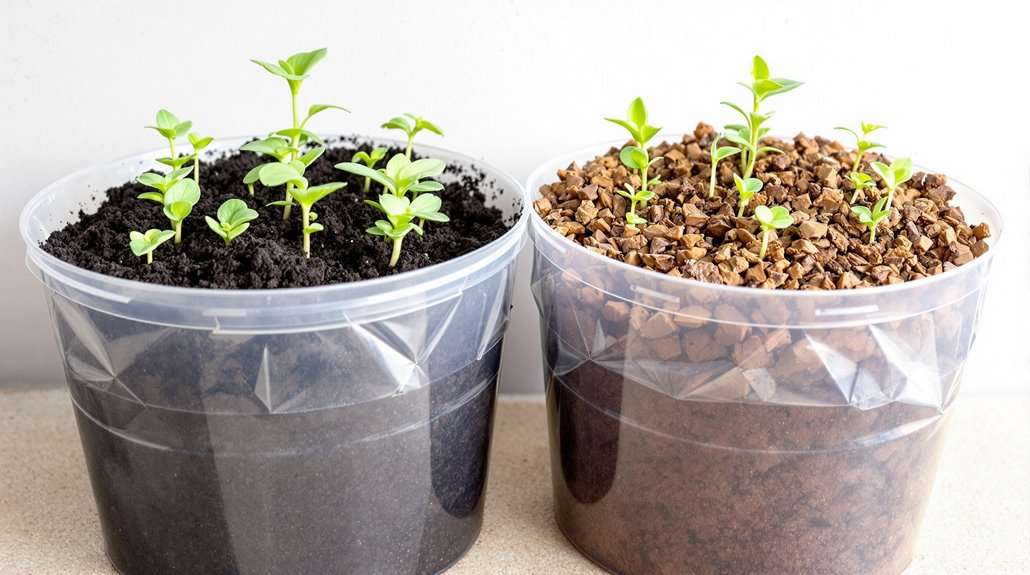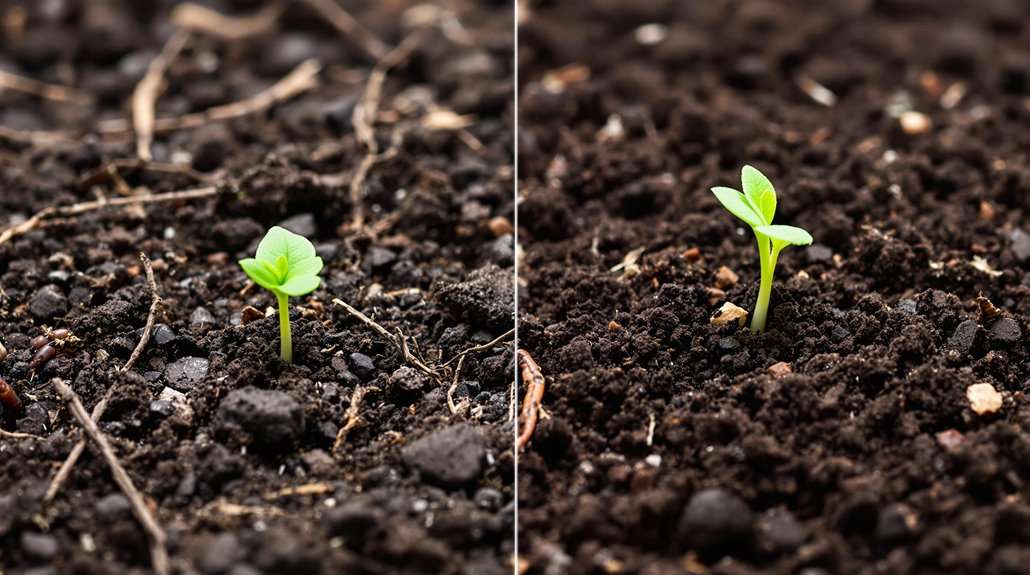Topsoil Vs Compost
Topsoil and compost serve different but complementary roles in your garden. Topsoil, the natural uppermost layer of earth extending 5-10 inches deep, contains a mix of mineral particles and organic matter that's ideal for filling low spots and creating new garden beds. Compost, on the other hand, is manufactured from decomposed organic materials like food scraps and yard waste, making it rich in nutrients and beneficial microorganisms. You'll get the best results by combining them in a 3:1 ratio of topsoil to compost for most garden applications, though specific ratios may vary based on your garden's needs. Understanding their distinct properties will help you make smarter choices for your landscape projects.
This post may contain affiliate links. If you make a purchase through these links, I may earn a commission at no additional cost to you. Additionally, portions of this post may be generated using artificial intelligence (AI) technology. While we strive for accuracy, please be aware that AI-generated content may not always be perfect and should be fact-checked when necessary.
The Spatula Scoops
- Topsoil is the natural upper layer of earth (5-10 inches deep), while compost is manufactured from decomposed organic materials.
- Topsoil excels at filling low spots and leveling ground, whereas compost primarily improves soil fertility and structure.
- Compost contains higher concentrations of nutrients and active decomposers than topsoil, making it better for soil enrichment.
- A 3:1 ratio of topsoil to compost creates ideal growing conditions for most garden applications.
- Topsoil provides stable foundation and structure, while compost delivers concentrated nutrients that release slowly into soil.
What Are They

When it comes to gardening and landscaping, understanding the difference between topsoil and compost is crucial for success. These two materials serve distinct purposes in your garden, and knowing their unique characteristics will help you make better choices for your plants.
Topsoil is nature's original growing medium, forming the uppermost layer of earth that extends roughly 5-10 inches deep. You'll find it's a mixture of mineral particles and organic matter, making it the most biologically active layer of soil where most plant roots thrive. It's classified as either the O Horizon or A Horizon in soil science, and it's essential for supporting vegetation due to its ability to retain water and nutrients. The presence of organic matter content enhances its physical properties like tilth, structure, and water-holding capacity. Chinchillas, like plants, also require a specific environment to thrive, with temperatures below optimal temperature being crucial for their health.
Compost, on the other hand, is a manufactured product you create from decomposed organic materials like food scraps, leaves, and yard waste. While topsoil is your primary growing medium, compost works as a powerful soil amendment that improves soil structure and adds essential nutrients. You'll often find it's darker and richer than topsoil, with a purely organic composition that's ideal for enhancing your garden's growing conditions.
Essential Components
A gardener's success often depends on understanding the essential building blocks of both topsoil and compost. You'll find that topsoil contains a complex mixture of organic matter, minerals, and microorganisms that form naturally as the earth's uppermost layer. It's composed of pulverized rock, water, air, and humus, providing the structural foundation your plants need. In optimal conditions, soil organisms and worms transform organic material into vital plant nutrients. Rich in vitamins and antioxidants, a diet that includes watercress can greatly benefit overall health.
- Topsoil typically contains varying ratios of sand, clay, and silt, determining its texture and drainage properties
- Compost consists of fully decomposed organic materials like leaves, kitchen scraps, and yard waste
- Both materials contain beneficial microorganisms, but compost has a higher concentration of active decomposers
When you're working with compost, you're dealing with a manufactured product that's rich in nutrients and beneficial microbes. It's created through the careful decomposition of both nitrogen-rich and carbon-based materials. Unlike topsoil's natural composition, compost is specifically designed to enhance soil structure and promote nutrient availability. You'll get the best results by combining both materials, as topsoil provides the necessary structure while compost enriches it with nutrients and improves its overall quality.
Practical Uses in Gardening

Understanding the practical applications of topsoil and compost will help you make informed decisions for your garden's success. When you're working with topsoil, you'll find it's excellent for filling low spots and raising ground levels, particularly in early spring when soil conditions are ideal. You'll want to start by tilling the existing soil, adding a 3-inch layer of topsoil, and mixing them together to create a smooth shift. Quality topsoil should be screened and debris-free for optimal planting conditions. Additionally, using high-quality utensils, such as stainless steel spoons, can make a difference in your overall gardening experience.
While topsoil provides structure and moisture retention, it's not a complete solution on its own. You'll need to combine it with compost to maximize your garden's potential. Compost adds essential nutrients and improves soil health, making it particularly valuable when mixed with topsoil in raised beds or garden plots. For best results, you'll want to add compost in both spring and fall, applying a 2-inch layer before the growing season begins. When using compost on lawns, apply it after aerating or dethatching to guarantee proper integration. Remember that while topsoil offers bulk and structure, compost provides the biological activity and nutrient density your plants need for peak growth.
Environmental Impact and Formation
The environmental footprint of topsoil and compost reveals significant differences in their formation and impact on our planet. While topsoil forms naturally over extended periods through organic matter decomposition, you'll find that compost is created through a controlled process that reduces methane emissions and diverts waste from landfills. Six inches of soil is currently required by federal regulations as daily cover at landfills.
- Compost actively sequesters carbon into the soil, preventing its release as CO2
- Topsoil develops in the uppermost 5-10 inches of earth, hosting essential biological activities
- Both materials improve water quality, but compost offers immediate environmental benefits
- By incorporating flavorful fried rice into meal planning, individuals can reduce food waste and support sustainable practices.
When you're considering environmental impact, you'll notice that compost's formation requires specific conditions: proper carbon-to-nitrogen ratios, adequate moisture, and oxygen flow. Topsoil, however, develops gradually through natural processes, creating a loamy texture that's ideal for drainage and nutrient retention. You'll find compelling evidence that using compost as landfill cover can reduce global warming potential in 63% of cases, while its use as a soil amendment helps limit resource depletion in 96% of scenarios. Both materials play key roles in maintaining soil health, but compost's controlled formation process allows for more immediate environmental benefits through waste reduction and methane emission control.
Benefits for Plant Growth

For ideal plant growth, topsoil and compost each bring distinct yet complementary benefits to your garden. You'll find that topsoil provides a stable foundation with its balanced mixture of organic matter, minerals, and beneficial microorganisms, while compost delivers concentrated nutrients that release slowly into your soil. The combination of these materials promotes microbial activity, helping to break down organic matter into usable nutrients. Raised garden beds, with their improved drainage, are an excellent way to utilize this mixture, as they allow for better soil aeration and fewer waterlogging issues.
When you combine these materials, you're creating a superior growing environment. Using a 3:1 ratio of topsoil to compost will give you the best results for most garden applications. This mixture enhances both water retention and nutrient availability while maintaining proper soil structure. For more demanding plants, you can adjust to a 1:1 ratio, but be careful not to over-enrich your soil, as this could lead to nutrient imbalances.
Choosing the Right Option
Making an informed choice between topsoil and compost depends largely on your gardening goals and existing soil conditions. If you're starting a new garden or need to level your landscape, you'll want to focus on topsoil, which typically ranges from 4-12 inches deep and contains a mix of silt, sand, and clay. However, if you're looking to improve your soil's fertility and structure, compost is your best option. When using topsoil, you should till into existing soil to create a proper transition layer. Proper food storage techniques, such as those used for applesauce shelf life, can also be applied to store gardening supplies, like seeds and fertilizers, to extend their shelf life.
- For new lawn establishment, use topsoil as your foundation layer, then incorporate compost to enhance nutrient content
- When creating raised beds, combine both materials in a 70:30 ratio of topsoil to compost for ideal growing conditions
- For existing gardens, apply compost as a 2-3 inch top layer to gradually improve soil health
You'll find that combining both materials often yields the best results. While topsoil serves as your garden's foundation, compost acts as its vitamin supplement. If you're working with clay-heavy topsoil, you can improve its structure by mixing in compost. Remember that while topsoil works as fill dirt, compost shouldn't be used for this purpose. Instead, use compost as an amendment to enhance your soil's organic matter content over time.
Frequently Asked Questions
Can Topsoil or Compost Alone Be Used for Growing Potted Plants?
You wouldn't want to use either topsoil or compost alone – that'd be like trying to bake a cake with just flour or just eggs. For potted plants, you'll need a proper mix. Topsoil becomes too compacted and lacks proper drainage, while compost alone is too nutrient-rich and doesn't provide adequate structure. Instead, you should use a balanced potting mix or create your own by combining components like perlite, vermiculite, and quality compost.
How Long Does Compost Need to Age Before Mixing With Topsoil?
You'll need to age your compost for 2-3 months before mixing it with topsoil, though timing can vary based on your materials and conditions. Watch for key indicators of maturity: your compost should be dark brown, crumbly, and smell earthy. If you're seeing white fungal growth or your pile's still hot, it's not ready. You can test maturity by checking if seedlings grow well in a small sample.
What Is the Ideal Depth Ratio When Layering Topsoil and Compost?
When layering your soil, you'll want to follow specific depth ratios for ideal results. For new beds, mix 1-2 inches of compost into the top 6-8 inches of soil. If you're working with raised beds, combine compost and soilless growing mix in a 1:1 ratio. For compacted soil, layer a blend of compost and topsoil in a 1:2 ratio on top, then work it in gradually.
Does Winter Weather Affect the Decomposition Rate of Compost Differently Than Topsoil?
Winter weather affects compost decomposition more dramatically than topsoil. You'll notice your compost's decomposition rate slows substantially in cold temperatures due to reduced microbial activity, while topsoil maintains a more stable decomposition rate year-round. This difference occurs because compost's active microbial population is more sensitive to temperature changes, and its organic matter breaks down faster in ideal conditions than topsoil's natural decomposition process.
Can Diseased Plants Be Composted, or Should They Go Into Topsoil?
You shouldn't add diseased plants to either topsoil or regular compost piles, as they can spread pathogens to healthy plants. If you're determined to compost them, you'll need to use hot composting methods that maintain temperatures above 131°F to kill pathogens. Your safest option is to dispose of diseased plants separately, either through municipal waste services or by burning them where legally permitted.





